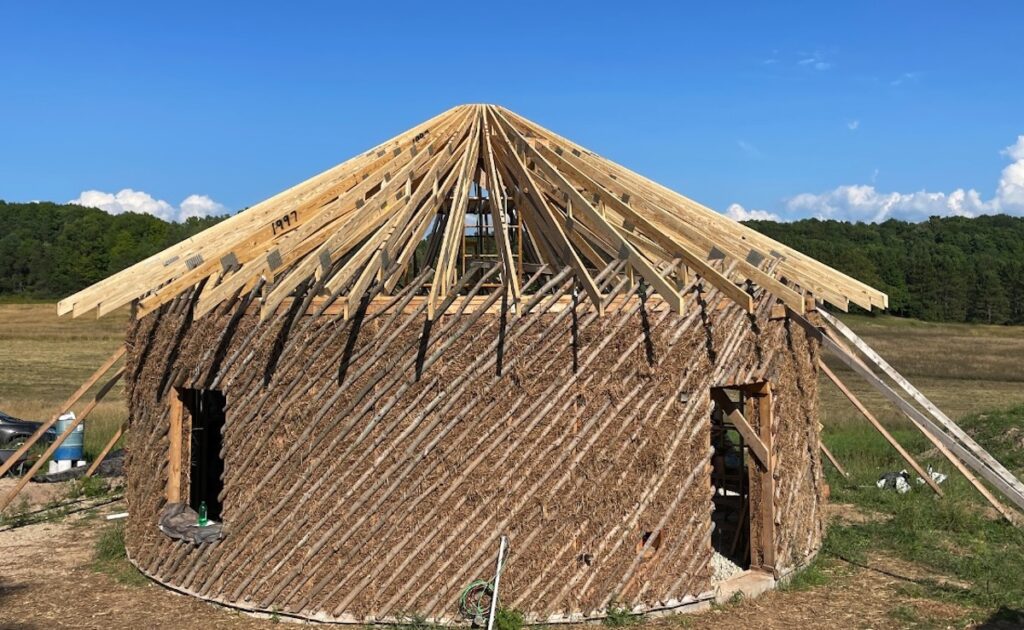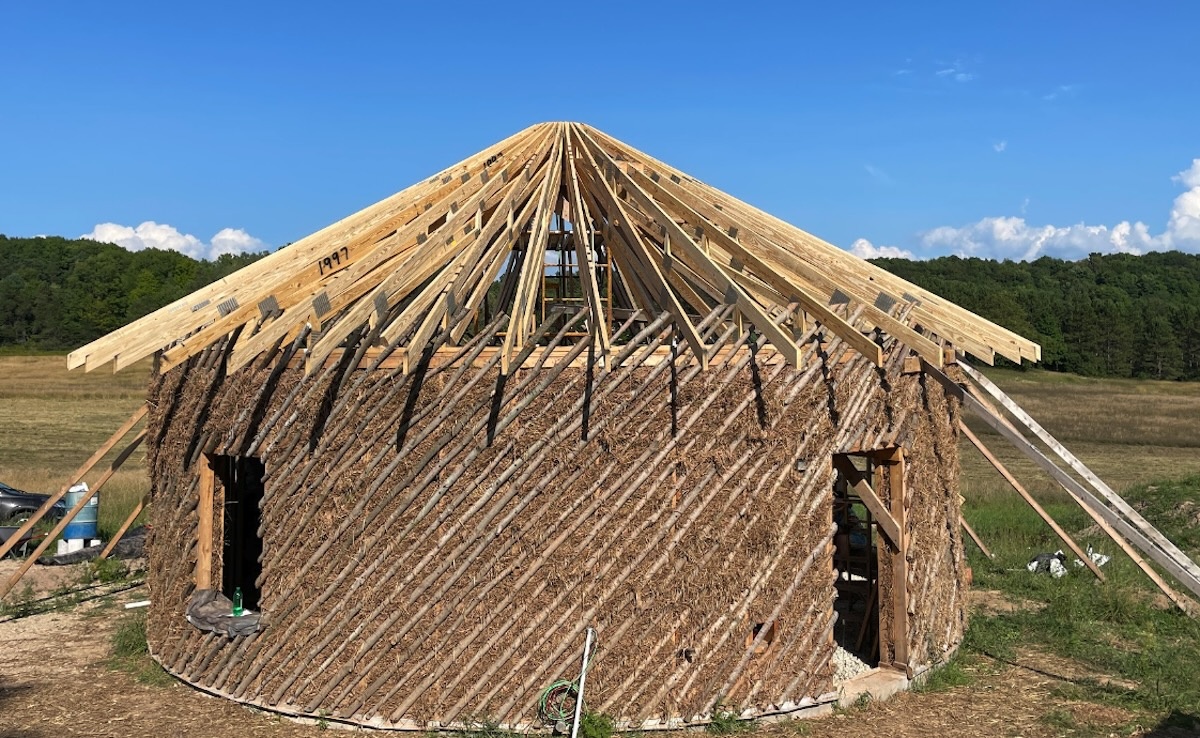On a rural farm near Bear Lake, Michigan, builder Thomas Hirsch and architectural designer Ellis Wills Begley are embracing sustainable methods by incorporating materials like straw-clay insulation, black locust wood, and foamed glass aggregate.
The studio they are building is in a circular form because round shapes are inherently natural and create a sense of openness, free from the harsh edges of conventional design. “Circles create comfortable, inclusive spaces that don’t have the hidden corners that collect shadows or dust,” Begley explains.
Hirsch says, “It poses unique structural requirements that you don’t face with a rectangular house, but I enjoy that challenge, and the owner was keen on this design, so we made it work.”
 The round design required innovative techniques, including diagonal bracing, which Hirsch likened to creating a basket. “The diagonal bracing creates a strong, supportive framework,” he says. “This was our first straw-clay round house, and it came with its own set of challenges, but the result is something really beautiful.”
The round design required innovative techniques, including diagonal bracing, which Hirsch likened to creating a basket. “The diagonal bracing creates a strong, supportive framework,” he says. “This was our first straw-clay round house, and it came with its own set of challenges, but the result is something really beautiful.”
“Straw is an amazing material—it’s hollow, so it traps air, making it an excellent insulator,” Hirsch says. “And when you mix it with clay, it becomes resistant to fire and mold.”
“The materials are dirt cheap—literally,” Hirsch jokes. “But it takes a lot of hands-on work. That’s why we often involve the homeowners in the process. They can contribute to the build, whether it’s mixing straw and clay or applying natural plasters.”
Thomas also notes that the use of straw-clay insulation is now code-approved in Michigan, which has helped reduce the hurdles for builders interested in using this sustainable material. “It’s been approved since 2015, which makes things a lot easier. But back when we first started using straw-clay, we had to present engineering reports to get it through the building department. Now, it’s recognized as a viable method.”
Another key material in the studio is black locust wood, chosen for its natural durability and resistance to rot. “Black locust is one of the most rot-resistant woods that grows in America,” Hirsch says. “It’s super hard and can be a little tricky to work with because of its grain, but once you get the hang of it, it’s fantastic. It’s also an invasive species in some areas, so using it is kind of a win-win—getting rid of an unwanted species while building with a material that will last.” Unlike chemically treated lumber, which can release toxins, black locust offers a natural, non-toxic alternative that aligns with the project’s broader goal of creating a healthy living space.
Beneath the studio’s floor is foamed glass aggregate. Made from 100 percent recycled post-consumer glass, this material provides a sustainable alternative to Styrofoam insulation. “Foamed glass aggregate is one of my favorite materials,” Begley says. “It’s non-toxic, made from recycled glass, and doesn’t produce harmful dust during installation. Plus, it allows moisture to move freely, which helps prevent mold.” By using foamed glass aggregate, the builders were able to eliminate the need for plastic vapor barriers, further reducing the project’s environmental impact.
Hirsch has seen a growing interest in natural building methods, particularly from clients who are looking for healthier homes. “People are starting to question the materials we’ve been using for decades,” he explains. “They want homes that don’t off-gas toxic chemicals, homes that are energy-efficient and environmentally friendly.”
Hirsch says, “One of my dreams is to create a natural building and design institute here in northwest Michigan. We need more people trained in these methods, and we need to keep experimenting with new materials and techniques. There’s so much potential—whether it’s using mushrooms as insulation or finding new ways to sequester carbon in the building process.”
And rather than doing all the work individually, there could be benefits to going back to the barn-raising days of yore, where communities and trained experts would work together. “If we can create a system where people help each other build, like a cooperative labor pool, we can reduce costs and make natural building more feasible for a wider range of people,” Hirsch adds.
As for the round studio home, it stands as a testament to what’s possible when innovation and sustainability come together. “It’s a labor of love,” Hirsch says. “But when you see the finished product, it’s all worth it.”
You can read the original article at www.northernexpress.com


Very innovative